Mobilizing Adaptation Finance in Developing Countries
Research report
Permanent lenke
http://hdl.handle.net/11250/2435614Utgivelsesdato
2017-03-23Metadata
Vis full innførselSamlinger
- CICERO Reports [210]
Sammendrag
More funding is needed for adaptation to climate change, particularly in developing countries. Mobilization of adaptation finance is difficult due to uncertainties related to frequency, severity and geographical spread of climate change impacts, and intangibility due to a mismatch between long-term payback and the short-term horizon of private investors, difficulties in sorting out climate change related adaptations from adaptations motivated by other factors, and since many adaptation projects have public good properties.
Given these barriers, most adaptation finance has been stimulated from public sources such as bilateral and multilateral climate funds, as the private sector usually is deterred by the lack of a reasonably secured revenue stream. Furthermore, there is lack of regulatory policies that could create demand for adaptation projects from the private sector. Nevertheless, some examples of private sector investment in adaptation have occurred, most notably related to crop resilience, financial services, and business climate risk services.
This report examines barriers to stimulating adaptation finance within the context of different policies, instruments and approaches currently being implemented. Innovations related to adaptation finance have been produced, foremost creating a business case for adaptation in the agriculture and water sectors. Examples of innovations are disaster risk management for adaptation, climate insurance arrangements, credit mechanisms, micro-finance, green bonds, climate resilience bonds, and catastrophe swaps.
Proposed policy initiatives to stimulate increased adaptation finance flows include: Exploring crediting mechanisms; aligning disaster risk financing with climate adaptation policies; investigating micro-insurance for the lower socio-economic groups, and catastrophe bonds for institutional investors; promoting uptake of catastrophe swaps and resilience bonds to upscale financial flows; assessing aggregation and securitization for green bonds with proceeds earmarked for adaptation projects; and incentivizing adaptation in agriculture and water management.
